Eric Clapton (1945- )
Eric Clapton (1945- ) is an English rock and blues guitarist, singer, and songwriter. He is the only three-time inductee to the Rock and Roll Hall of Fame: once as a solo artist and separately as a member of the Yardbirds and Cream.
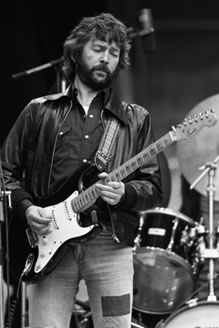 Clapton has been referred to as one of the most important and influential guitarists of all time. Clapton ranked second in Rolling Stone magazine’s list of the “100 Greatest Guitarists of All Time”[2] and fourth in Gibson’s “Top 50 Guitarists of All Time”. He was also named number five in Time magazine’s list of “The 10 Best Electric Guitar Players” in 2009.
Clapton has been referred to as one of the most important and influential guitarists of all time. Clapton ranked second in Rolling Stone magazine’s list of the “100 Greatest Guitarists of All Time”[2] and fourth in Gibson’s “Top 50 Guitarists of All Time”. He was also named number five in Time magazine’s list of “The 10 Best Electric Guitar Players” in 2009.
In the mid-1960s Clapton left the Yardbirds to play with John Mayall & the Bluesbreakers. Immediately after leaving Mayall, Clapton formed the power trio Cream with drummer Ginger Baker and bassist Jack Bruce, in which Clapton played sustained blues improvisations and “arty, blues-based psychedelic pop”.
Furthermore, he formed blues rock band Blind Faith with Baker, Steve Winwood, and Ric Grech. For most of the 1970s Clapton’s output bore the influence of the mellow style of J. J. Cale and the reggae of Bob Marley. His version of Marley’s “I Shot the Sheriff” helped reggae reach a mass market. Two of his most popular recordings were “Layla”, recorded with Derek and the Dominos; and Robert Johnson’s “Crossroads”, recorded with Cream. Following the death of his son Conor in 1991, Clapton’s grief was expressed in the song “Tears in Heaven”, which was featured on his Unplugged album.
Buddy Holly (1936-1959)
Buddy Holly (1936-1959) was an American musician and singer-songwriter who was a central figure of mid-1950s rock and roll. Holly was born in Lubbock, Texas, to a musical family during the Great Depression; he learned to play guitar and to sing alongside his siblings. His style was influenced by gospel music, country music, and rhythm and blues acts, and he performed in Lubbock with his friends from high school. He made his first appearance on local television in 1952, and the following year he formed the group “Buddy and Bob” with his friend Bob Montgomery. In 1955, after opening for Elvis Presley, Holly decided to pursue a career in music. He opened for Presley three times that year; his band’s style shifted from country and western to entirely rock and roll. In October that year, when he opened for Bill Haley & His Comets, Holly was spotted by Nashville scout Eddie Crandall, who helped him get a contract with Decca Records.
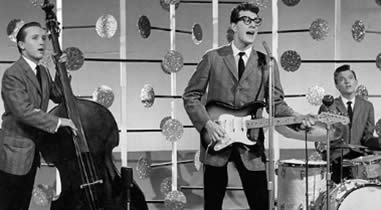 Holly’s recording sessions at Decca were produced by Owen Bradley. Unhappy with Bradley’s control in the studio and with the sound he achieved there, Holly went to producer Norman Petty in Clovis, New Mexico, and recorded a demo of “That’ll Be the Day”, among other songs. Petty became the band’s manager and sent the demo to Brunswick Records, which released it as a single credited to “The Crickets”, which became the name of Holly’s band. In September 1957, as the band toured, “That’ll Be the Day” topped the US “Best Sellers in Stores” chart and the UK Singles Chart. Its success was followed in October by another major hit, “Peggy Sue”.
Holly’s recording sessions at Decca were produced by Owen Bradley. Unhappy with Bradley’s control in the studio and with the sound he achieved there, Holly went to producer Norman Petty in Clovis, New Mexico, and recorded a demo of “That’ll Be the Day”, among other songs. Petty became the band’s manager and sent the demo to Brunswick Records, which released it as a single credited to “The Crickets”, which became the name of Holly’s band. In September 1957, as the band toured, “That’ll Be the Day” topped the US “Best Sellers in Stores” chart and the UK Singles Chart. Its success was followed in October by another major hit, “Peggy Sue”.
The album Chirping Crickets, released in November 1957, reached number five on the UK Albums Chart. Holly made his second appearance on The Ed Sullivan Show in January 1958 and soon after, toured Australia and then the UK. In early 1959, Holly assembled a new band, consisting of future country music star Waylon Jennings (bass), famed session musician Tommy Allsup (guitar), and Carl Bunch (drums), and embarked on a tour of the midwestern U.S. After a show in Clear Lake, Iowa, Holly chartered an airplane to travel to his next show, in Moorhead, Minnesota. Soon after takeoff, the plane crashed, killing Holly, Ritchie Valens, The Big Bopper, and pilot Roger Peterson in a tragedy later eulogized by Don McLean as “The Day the Music Died”.
During his short career, Holly wrote, recorded, and produced his own material. He is often regarded as the artist who defined the traditional rock-and-roll lineup of two guitars, bass, and drums. Holly was a major influence on later popular music artists, including The Beatles, The Rolling Stones, Eric Clapton, and Elton John. He was among the first artists inducted into the Rock and Roll Hall of Fame, in 1986. Rolling Stone Magazine ranked him number 13 in its list of “100 Greatest Artists”.
Chet Atkins (1924-2001)
Chet Atkins (1924-2001) was an American musician, occasional vocalist, songwriter, and record producer, who along with Owen Bradley and Bob Ferguson, among others, created the country music style that came to be known as the Nashville sound, which expanded country music’s appeal to adult pop music fans. He was primarily known as a guitarist. He also played the mandolin, fiddle, banjo, and ukulele.
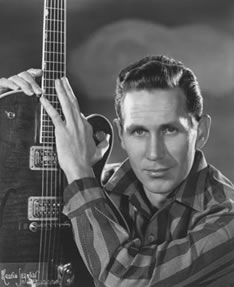 Atkins’ signature picking style was inspired by Merle Travis. Other major guitar influences were Django Reinhardt, George Barnes, Les Paul, and, later, Jerry Reed. His distinctive picking style and musicianship brought him admirers inside and outside the country scene, both in the United States and abroad. Atkins spent most of his career at RCA Victor and produced records for the Browns, Hank Snow, Porter Wagoner, Norma Jean, Dolly Parton, Dottie West, Perry Como, Floyd Cramer, Elvis Presley, the Everly Brothers, Eddy Arnold, Don Gibson, Jim Reeves, Jerry Reed, Skeeter Davis, Waylon Jennings, and many others.
Atkins’ signature picking style was inspired by Merle Travis. Other major guitar influences were Django Reinhardt, George Barnes, Les Paul, and, later, Jerry Reed. His distinctive picking style and musicianship brought him admirers inside and outside the country scene, both in the United States and abroad. Atkins spent most of his career at RCA Victor and produced records for the Browns, Hank Snow, Porter Wagoner, Norma Jean, Dolly Parton, Dottie West, Perry Como, Floyd Cramer, Elvis Presley, the Everly Brothers, Eddy Arnold, Don Gibson, Jim Reeves, Jerry Reed, Skeeter Davis, Waylon Jennings, and many others.
Among many honors, Atkins received 14 Grammy Awards and the Grammy Lifetime Achievement Award. He also received nine Country Music Association awards for Instrumentalist of the Year. He was inducted into the Rock & Roll Hall of Fame, the Country Music Hall of Fame and Museum, and the Musicians Hall of Fame and Museum.
Dave Davies (1947- )
Dave Davies (1947- ) an English singer, songwriter and guitarist. He is best known as the lead guitarist and occasional lead singer for the English rock band The Kinks, which also featured his older brother Ray Davies.
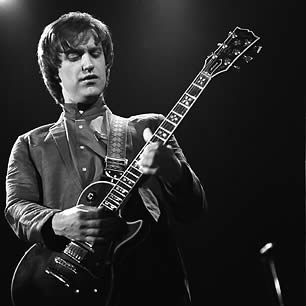
In 2003, Davies was ranked 91st in Rolling Stone Magazine’s list of the “100 Greatest Guitarists of All Timef Fame and Museum.
T-Bone Walker (1910-1975)
T-Bone Walker (1910-1975) was a critically acclaimed American blues guitarist, singer, songwriter and multi-instrumentalist, who was an influential pioneer and innovator of the jump blues and electric blues sound. In 2011, Rolling Stone magazine ranked him number 67 on its list of “The 100 Greatest Guitarists of All Time
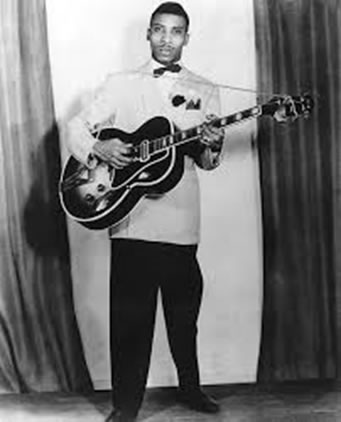
Les Paul (1915-2009)
Les Paul (1915-2009) was an American jazz, country, and blues guitarist, songwriter, luthier, and inventor. He was one of the pioneers of the solid-body electric guitar, which made the sound of rock and roll possible. Paul taught himself how to play guitar and while he is mainly known for jazz and popular music, he had an early career in country music.
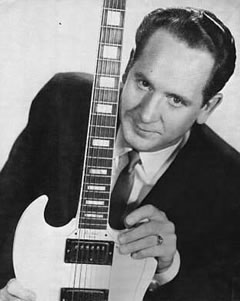 He is credited with many recording innovations. Although he was not the first to use the technique, his early experiments with overdubbing (also known as sound on sound), delay effects such as tape delay, phasing effects and multitrack recording were among the first to attract widespread attention.
He is credited with many recording innovations. Although he was not the first to use the technique, his early experiments with overdubbing (also known as sound on sound), delay effects such as tape delay, phasing effects and multitrack recording were among the first to attract widespread attention.
His innovative talents extended into his playing style, including licks, trills, chording sequences, fretting techniques and timing, which set him apart from his contemporaries and inspired many guitarists of the present day. He recorded with his wife Mary Ford in the 1950s, and they sold millions of records.
Among his many honors, Paul is one of a handful of artists with a permanent, stand-alone exhibit in the Rock and Roll Hall of Fame. He is prominently named by the music museum on its website as an “architect” and a “key inductee” along with Sam Phillips and Alan Freed. Les Paul is the only person to be included in both the Rock and Roll Hall of Fame and the National Inventors Hall of Fame.
Jeff Beck (1944- )
Jeff Beck (1944- ) is an English rock guitarist. He is one of the three noted guitarists to have played with The Yardbirds (the other two being Eric Clapton and Jimmy Page). Beck also formed The Jeff Beck Group and Beck, Bogert & Appice.
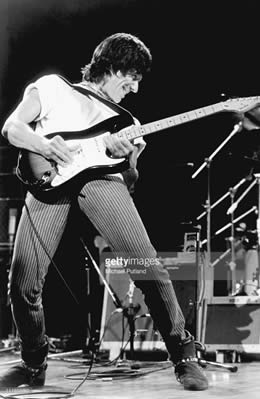 Much of Beck’s recorded output has been instrumental, with a focus on innovative sound, and his releases have spanned genres ranging from blues-rock, hard rock, jazz fusion, and an additional blend of guitar-rock and electronica. Although he recorded two hit albums (in 1975 and 1976) as a solo act, Beck has not established or maintained the sustained commercial success of many of his contemporaries and bandmates.
Much of Beck’s recorded output has been instrumental, with a focus on innovative sound, and his releases have spanned genres ranging from blues-rock, hard rock, jazz fusion, and an additional blend of guitar-rock and electronica. Although he recorded two hit albums (in 1975 and 1976) as a solo act, Beck has not established or maintained the sustained commercial success of many of his contemporaries and bandmates.
Beck appears on albums by Mick Jagger, Tina Turner, Morrissey, Jon Bon Jovi, Malcolm McLaren, Kate Bush, Roger Waters, Donovan, Stevie Wonder, Les Paul, Zucchero, Cyndi Lauper, Brian May, Stanley Clarke, Screaming Lord Sutch, ZZ Top, and Toots and the Maytals.
He was ranked fifth in Rolling Stone’s list of the “100 Greatest Guitarists of All Time” and the magazine, upon whose cover Beck has appeared three times, has described him as “one of the most influential lead guitarists in rock”. He is often called a “guitarist’s guitarist”. Beck has earned wide critical praise and received the Grammy Award for Best Rock Instrumental Performance six times and Best Pop Instrumental Performance once. In 2014 he received the British Academy’s Ivor Novello Award for Outstanding Contribution to British Music. Beck has been inducted into the Rock and Roll Hall of Fame twice: as a member of the Yardbirds (1992) and as a solo artist (2009).
Howlin’ Wolf (1910-1976)
Howlin’ Wolf (1910-1976) was a Chicago blues singer, guitarist, and harmonica player, originally from Mississippi.
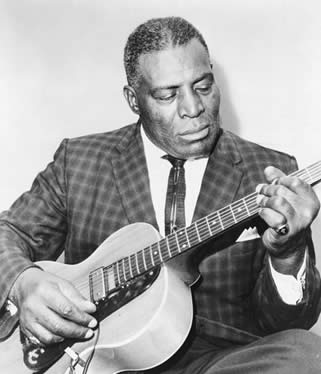 With a booming voice and looming physical presence, he is one of the best-known Chicago blues artists. Musician and critic Cub Koda noted, “no one could match Howlin’ Wolf for the singular ability to rock the house down to the foundation while simultaneously scaring its patrons out of its wits.”
With a booming voice and looming physical presence, he is one of the best-known Chicago blues artists. Musician and critic Cub Koda noted, “no one could match Howlin’ Wolf for the singular ability to rock the house down to the foundation while simultaneously scaring its patrons out of its wits.”
Producer Sam Phillips recalled, “When I heard Howlin’ Wolf, I said, ‘This is for me. This is where the soul of man never dies'”. Several of his songs, including “Smokestack Lightnin'”, “Back Door Man”, “Killing Floor” and “Spoonful”, have become blues and blues rock standards. In 2004, Rolling Stone magazine ranked him number 51 on its list of the “100 Greatest Artists of All Time
